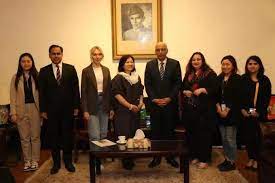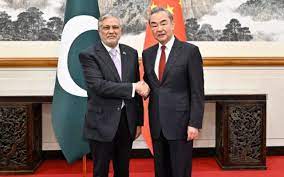Gandhara art exhibition continues to attract visitors at Palace Museum in Beijing

Beijing: The three-month-long exhibition jointly organized by the Palace Museum and Department of Archaeology and Museums of Pakistan, supported by the Pakistan Embassy Beijing, continued to attract general visitors, professionals, scholars and other lovers of art and culture.
The exhibition opened last month, and also included a multimedia presentation, art installations, and interactive activities to help visitors understand the cultural history of the region.
A total of 203 artefacts, of which 173 come from seven museums in Pakistan and 30 from the Palace Museum are being showcased.
Ancient Gandhara was a thriving center of trade along the Silk Road.
The exhibition is also one of the major events being held to celebrate 2023 as the Year of China-Pakistan Tourism Exchanges.
Pakistan Ambassador to China, Moin Ul Haque said that the exhibition has generated a lot of interest among Chinese people and it will further promote cultural and people exchanges between Pakistan and China.
He said that initially, the exhibition was organized for three months but owing to interest shown by people, it is expected to continue for months.
Federal Secretary, National Heritage and Culture Division, Ms Fareena Mazhar who led the Pakistani delegation in the opening ceremony told APP that exhibition  will help promote the shared heritage and enhance people to contact between Pakistan and China.
Underlining the centrality of this exhibition as a landmark event in the cultural cooperation between the two countries, she hoped that the event would be beneficial not only to the general public but also to Chinese scholars and professionals to understand the cultural heritage of Pakistan.
In exchange for scholars from both countries, the federal secretary informed that the Chinese scholars could visit sites in Pakistan and scholars from Pakistan come and visit China.
The Chinese side has also offered to train Pakistani experts and we will send our young professional to get expertise, she added.
Deputy Director Museums, Dr. Mahmood ul Hassan who was present at the launch of the exhibition said that Pakistan should further learn from China’s successful efforts to preserve their own ancient art.
By studying how China has successfully preserved their own ancient Gandhara art and applying similar methods to Pakistani stone crafts, Pakistan can ensure that these beautiful works are preserved for generations to come, he added.
Pakistan has a rich cultural heritage, particularly in the form of Gandhara art. However, due to a lack of resources and infrastructure, it is difficult for Pakistani artisans to preserve this ancient art. In order to better preserve this precious cultural asset, Pakistan should look to China for guidance and inspiration.
He stated that Chinese culture has a long history of preserving traditional arts and crafts through the use of modern technology and techniques. By learning from China’s example, Pakistani artisans can ensure that their country’s unique cultural heritage is preserved for future generations.
Gandhara archaeological sites mainly spread across the southern end of the present-day Hindu Kush and Karakorum mountains ranges in northern Pakistan. This also is an area of the ancient Silk Road that intersected with Mediterranean civilization, Iranian civilization and Indian civilization.
China and Pakistan are both ancient civilizations on the Silk Road with a long history of cultural and artistic exchanges. Historical records show that between 400AD and 630AD, ancient Chinese monks traveled to Pakistan and left written materials about Gandhara culture. Chinese artifacts, inscriptions, and coins have also been discovered in many archaeological sites in Pakistan, giving remarkable evidence of historical China-Pakistan exchanges.
The exhibition, lasting until June 15, aims to demonstrate the artistic charm of Gandhara culture and its far-reaching influence on China and East Asia.





